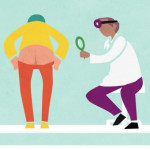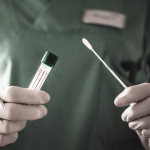Only a minority of adults considered to be at risk of acquiring HIV, including people who inject drugs and those who reported high-risk sexual behavior, have been vaccinated against the human papillomavirus (HPV), which can cause cervical, anal, oral and other cancers, according to a report at the recent American Association for Cancer Research (AACR) annual meeting.
HPV is primarily transmitted via sex, and most sexually active people carry some of the more than 100 known types. HPV triggers abnormal cell growth, including warts and precancerous tissue changes known as dysplasia. If left untreated, these abnormal changes can progress to invasive cervical, anal, genital or mouth and throat cancers. HPV sometimes clears up naturally, but people living with HIV are more likely to have persistent infection and to develop advanced disease.
HPV infection can be prevented with a vaccine. The original Gardasil vaccine and the Cervarix vaccine offered protection against two high-risk, or cancer-causing, HPV types, 16 and 18. Gardasil also protects against HPV types 6 and 11, which cause genital warts. The newer Gardasil 9 prevents five additional high-risk HPV types (31, 33, 45, 52 and 58). The standard vaccine series involves two injections for adolescents and three doses for people over age 15 and those with compromised immunity.
HPV vaccines are more effective when given to young people before they become sexually active. The Centers for Disease Control and Prevention’s Advisory Committee on Immunization Practices (ACIP) recommends HPV vaccination for boys and girls at age 11 or 12. About half of adolescents are fully vaccinated, according to the CDC.
For those not vaccinated as adolescents, ACIP recommends vaccination up to age 26 for women, gay and bi men, and people with compromised immunity—including those living with HIV—and up to age 21 for other men. ACIP considers HIV-positive people to be a special population of interest because of their increased risk of HPV-associated cancers, according to Lisa Wigfall, PhD, of Texas A&M University in College Station.
The Food and Drug Administration recently approved Gardasil 9 for adults up to age 45 after a study showed that the vaccine was still partially effective in older women. However, this indication is not yet recommended by ACIP, and the cost may not be covered by insurance.
Wigfall presented results from a study of HPV vaccination rates using data from the CDC’s Behavioral Risk Factor Surveillance System (BRFSS), which conducts telephone surveys about health-related risk behaviors, chronic health conditions and use of prevention services.
Of the 486,303 adults who completed the 2016 BRFSS survey, only 16,507—or 3.4%—reported that they had injected drugs or engaged in high-risk sexual behavior during the past year, including exchanging sex for money, having unprotected anal sex, having four or more sex partners or being diagnosed with a sexually transmitted infection. The survey did not ask about HIV status, so it is unclear how many of these at-risk individuals may have already been HIV positive, Wigfall noted.
Within the at-risk group, just 416 had full data about HPV vaccination rates. Among the evaluable heterosexual women ages 18 to 36 who were classified as being at risk, about a quarter had completed the three-shot HPV vaccine series. Among evaluable gay and bisexual men ages 18 to 33, about a quarter had started the vaccine series, but only 6.2% had completed it. Among high-risk heterosexual men ages 18 to 28, just 10.9% had started the series. None of the small number of transgender men and women or gender-nonconforming individuals in the study had started the series.
Wigfall also reported that HPV vaccination rates were substantially lower among Black people—who have the highest HIV rates—compared with other racial and ethnic groups.
"It was alarming that almost all non-Hispanic Blacks in the study were unvaccinated, especially given the disproportionate burden of HIV/AIDS among this minority group," Wigfall said in an AACR press release.
People who had been tested for HIV were more likely to have started and to have completed the HPV vaccine series, but the difference was not statistically significant, meaning it could have been attributable to chance.
Wigfall suggested that providers may not be recommending HPV vaccination for people living with or at risk for HIV, including gay and bi men and transgender people, and recommended that clinicians should increase their communication about the vaccine. She also recommended routine HIV testing for all adolescents and adults, regardless of perceived risk.
"Taking known HIV/AIDS and HPV-related cancer disparities among racial/ethnic and sexual/gender minority populations into account, it is essential that increasing HPV vaccination rates among unvaccinated HIV infection high-risk adults remain a public health priority," Wigfall and colleagues concluded.
Click here to read the AACR study abstract.
Click here to learn ore about the HPV vaccine.







Comments
Comments